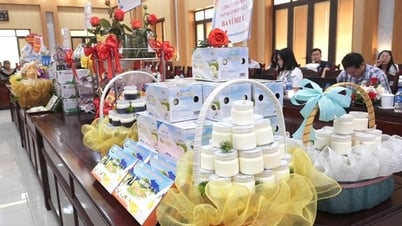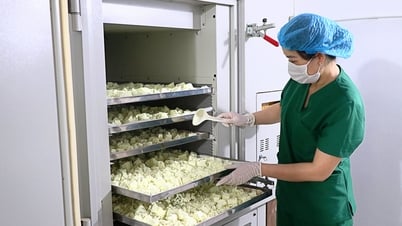“While houseplants can't get rid of black mold that's already formed, they can help reduce indoor humidity and prevent mold stains from forming,” explains Angela Slater, horticultural expert at Hayes Garden World.
Mold is caused by low temperatures and humidity in the home and can be unsightly, difficult to remove and dangerous to health, especially for people with asthma.
Increasing the temperature and using a dehumidifier are common ways to get rid of mold. However, certain houseplants can help with this problem.
It has been noted that in indoor areas with these plants, the number of fungal and bacterial spores is reduced by 40-60%. They reduce the humidity in the room that causes mold by absorbing moisture through their leaves.
Here are 6 types of plants that effectively help prevent mold, as suggested by experts in the field of gardening.
Peace lily
Peace lilies are the perfect houseplants because they require little care and thrive in warm, humid environments like bathrooms and kitchens as they absorb moisture from the air through their leaves.
"The larger the plant, the more effective it is at removing mold. In addition, peace lilies also have the ability to remove toxins from the air and exchange carbon dioxide for life-giving oxygen," Angela explains.

Peace lilies also have the ability to absorb moisture and remove toxins from the air (Photo: Anything grows).
Experts also give advice on how to care for this plant, such as avoiding direct sunlight and keeping it moderately moist.
While peace lilies are great for reducing humidity in the home, they are not suitable for homes with pets. "One thing to note is to keep them away from pets as the leaves are poisonous if eaten," Angela warns.
Palm tree
Angela says there are many types of brushes that can help remove moisture and prevent mold.
“Palm trees are some of the most effective houseplants for cleaning the air and are especially good at removing common causes of mold through their leaves,” she says.

Palm trees are some of the most effective houseplants for cleaning the air (Photo: Spruce).
Palm trees that are good at preventing mold include Areca palm (safe for cats), Bamboo palm and Bamboo rattan.
“Palms need lots of light, but can tolerate some dryness, so they are ideal for those with no experience in growing and caring for plants. Larger plants are more likely to remove larger amounts of moisture,” Angela adds.
Spider plant
Spider plants are a popular houseplant, says Holly Crossley, a writer, professional gardener, and houseplant expert. "They're easy to care for and easy to grow, making them great for people who aren't particularly good at caring for plants."

Spider plants are popular houseplants (Photo: Spruce).
According to experts, this plant removes airborne toxins such as mold spores, as well as absorbs excess moisture to rebalance the indoor air. Moreover, this is one of the easiest houseplants to grow by cuttings. Therefore, you should multiply them, plant them in multiple pots and place the pots close together to enhance the dehumidification and anti-mold effect.
In addition, spider plants are very safe for pets, suitable for every family.
Snake plant
Snake plants are one of the most popular houseplants. According to gardening expert Angela, this plant is easy to care for, thrives in warm, humid environments, and is effective at preventing mold.
In addition, the snake plant also helps to effectively remove toxins from the air inside the house.

Snake plants help filter harmful pollutants, such as benzene and formaldehyde, from the air (Photo: Getty).
She recommends growing one large snake plant indoors or several of varying sizes.
“Not only are multiple plants more effective at removing mold, they are also aesthetically pleasing and grow better than a single plant because they create their own microclimate,” says Angela.
Snake plants do not require much water. In addition, this plant can grow well in both natural light and shady places.
Boston Fern
The Boston fern is one of the ideal bathroom plants because it thrives in high humidity.
"This native rainforest plant is great for low-light areas of the home, where mould and mildew can grow," says houseplant expert Holly Crossley. "It naturally absorbs moisture from the air through its leaves, helping to balance the humidity in your home."

Boston ferns are suitable for low-light areas in the home, where mold growth is likely to occur (Photo: Spruce).
In addition, experts also say that for Boston ferns, you only need to provide them with a little indirect sunlight and water them regularly to help them grow well and effectively filter the air.
ivy
"Ivy is also an effective anti-mold plant. It is one of the easiest plants to grow and can thrive in shade. For this plant, you should water it regularly to keep it moist, otherwise the leaves will turn yellow and fall off, thus reducing the plant's moisture absorption effect," said Angela.
English ivy is an ideal plant for the bathroom or kitchen because it thrives in humid environments. In fact, studies have found that it has the ability to remove benzene, trichloroethylene, and formaldehyde from the air.

Ivy grown in hanging baskets helps save room space (Photo: Uagoo).
You can grow them in hanging baskets, which are both decorative and do not take up space in the room.
However, Angela warns: "If you have pets, keep them away from the plant as its leaves are toxic to animals. Also, don't over-water the plant."
Source


![[Photo] Vice President Vo Thi Anh Xuan, French President Emmanuel Macron and his wife visit Hanoi University of Science and Technology](https://vphoto.vietnam.vn/thumb/1200x675/vietnam/resource/IMAGE/2025/5/27/267b6f2bdf3e46439f081b49f6ec26b1)


![[Photo] Hungarian President begins official visit to Vietnam](https://vphoto.vietnam.vn/thumb/1200x675/vietnam/resource/IMAGE/2025/5/27/ab75a654c6934572a4f1a566ac63ce82)






















































































Comment (0)